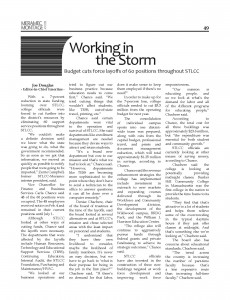Budget cuts force layoffs of 60 positions throughout STLCC
 Joe Douglas
Joe Douglas
– Editor-in-Chief Emeritus –
With a 7-percent reduction in state funding looming over STLCC, college officials were forced to cut further into the district’s resources by eliminating 60 support service positions throughout STLCC.
“We couldn’t make a definite decision until we knew what the state was going to do, what the government recommended. So as soon as we got that information, we moved as quickly as possible to notify people that were going to be impacted,” Zerrie Campbell, former STLCC-Meramec interim president, said.
Vice Chancellor for Finance and Business Services Carla Chance said 48 of the 60 positions were occupied. The 48 employees received notice on Feb. 4 and remained in their current positions until July 1.
Although STLCC looked at other ways of cutting funds, Chance said the layoffs were necessary. The departments that were affected by the layoffs include Human Resources, Technology and Educational Support Services (TESS), Continuing Education, Internal Audit, the STLCC Foundation, Purchasing and Maintenance/HVAC.
“We looked at our business operations and tried to figure out our business practice because education needs to come first,” Chance said. “We tried cutting things that wouldn’t affect students, like TESS, out-of-state travel, printing, etc.”
Chance said certain departments were vital to the operation and survival of STLCC. She said departments like enrollment management are needed because they devise ways to attract and retain students.
“It’s a brand new department but core to our mission and that’s what we had to look at,” Chance said. “However, departments like TESS are becoming more sophisticated to the point where they don’t have to send a technician to the office to answer questions; it can all be done over a computer remotely.”
Denise Chachere, chair of the board of trustrees at the time of the layoffs, said the board looked at several alternatives and at STLCC’s mission and chose selected areas with the least impact on personnel and students.
“I understand that they have their own livelihood to consider, maybe the livelihood of family members. It’s never an easy decision, but we have to go back to ‘what is their purpose for being in the job in the first place?’” Chachere said. “If there’s no demand for that labor, does it make sense to keep them employed if there’s no need?”
In order to make up for the 7-percent loss, college officials needed to cut $3.3 million from the operating budget for next year.
The consolidation of individual campus sports into one district- wide team was prepared, along with cuts from the capital budget, professional travel, and prints and document management reduction, which will total approximately $1.25 million in savings, according to Chance.
Chance said the revenue enhancement strategies the college has implemented include investment in outreach to new markets and expanding courses delivered through its Workforce and Community Development division, the development of the Wildwood campus, BRDG Park, and the William J. Harrison Education Center.
“The college also will continue to aggressively pursue funds through federal grants and private fundraising to achieve its strategic outcomes,” Chance said. STLCC officials have also invested in the construction of three new buildings targeted at work force development and improving work force responsiveness. “Our mission is educating people, and so we look at what’s the demand for labor and all of the different programs for educating people,” Chachere said.
According to Chance, the total cost for all three buildings was approximately $23.6 million, but “the expenditure was essential for both student and community growth.” STLCC officials are currently looking at other means of saving money, according to Chance. Chachere said the college is looking at potentially providing midnight classes. Bunker Hill Community College in Massachusetts was the first college in the nation to provide the time frame to its students.
“They find that that’s attractive to a lot of students and helps them relieve some of the overcrowding in the typical daytime hours if they just offer classes at midnight. And that’s something else we’re looking at,” Chachere said.
The board also has concerns about educational standards, Chachere said.
“The trend across the country is increasing the number of part-time faculty because that’s a less expensive route than increasing full-time faculty,” Chachere said.








